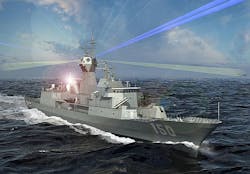Demand for shipboard power generation and control has no end in sight
Perhaps nowhere else, however, is power generation and control so important as it is aboard Navy surface warships. Future power demands aboard ship are staggering. Aircraft carriers, for example, are switching from steam power to electric power for aircraft catapults. Future cruisers, destroyers, frigates, and coastal combatants will carry laser weapons and electromagnetic guns to augment or replace missiles and deck cannon.
All-electric propulsion will be the norm on future Navy surface vessels, and with the growing number of wearable and deployable computers for sailors and Marines, surface ships also must become floating battery charging stations. None of this even touches on future needs for advanced shipboard radar, electro-optical sensors, tactical networking, and intra-ship communications.
With power demands like these, every naval ship afloat in the future also must become an underway power plant. There are power demands we'll see in the next couple of decades that no one's even dreamed of yet.
Fortunately, Navy researchers are doing their best to stay ahead of the power challenge. Just this month, for example, the Naval Sea Systems Command (NAVSEA) -- the Navy's primary organization for ship design -- inked a contract with the Florida State University Center for Advanced Power Systems (FSU CAPS) for advanced shipboard power research and development.
University are focusing on modeling, simulation and testing of Navy advanced shipboard electrical power systems and components. In addition, they'll create computer models of advanced shipboard electrical system components and entire shipboard power architectures.
Last month NAVSEA added money to a contract with the BAE Systems Platforms & Services segment to perfect an experimental containerized pulse power unit for the Navy's future power-hungry electromagnetic railgun -- a long-range shipboard weapon that will fire projectiles using electricity instead of chemical propellants.
BAE systems experts also will work on integrating batteries and containers aboard surface warships that will host the electromagnetic railgun, and create computer models of shipboard pulsed power. BAE Systems Platforms & Services has been developing a pulse power unit for the Navy electromagnetic railgun since late 2011.
Related: BAE Systems to continue development of shipboard power for Navy's electromagnetic railgun
There's more Navy research and development into shipboard power systems and technology than that.
Last year NAVSEA contracted with the RCT Systems Inc. Power Systems Division in Linthicum Heights, Md., to design experimental power-conversion modules and energy-storage components for shipboard power systems. RCT researchers are building and testing bi-directional power conversion modules to support a 4160-volt AC 60 Hz shipboard electrical architectures.
Future research into shipboard power generation and control is likely to continue ramping-up to help accommodate power-intensive weapons, sensors, and communications systems aboard even surface warships as small as the Littoral Combat Ship (LCS) and a new LCS variant that will function as a frigate.
There's no end to demands for power aboard ship. It's a good thing the Navy seems to have the matter in hand.
Learn more: search the Aerospace & Defense Buyer's Guide for companies, new products, press releases, and videos
